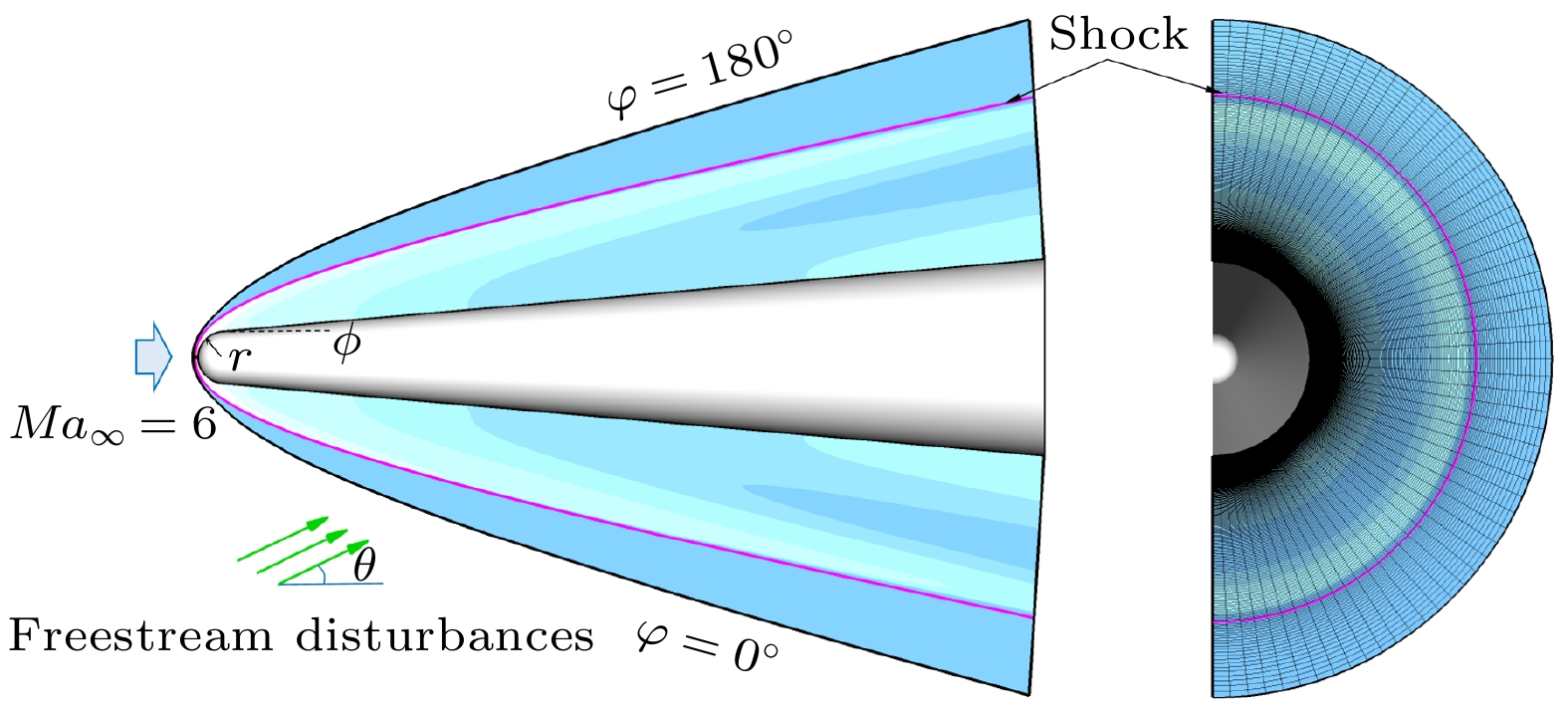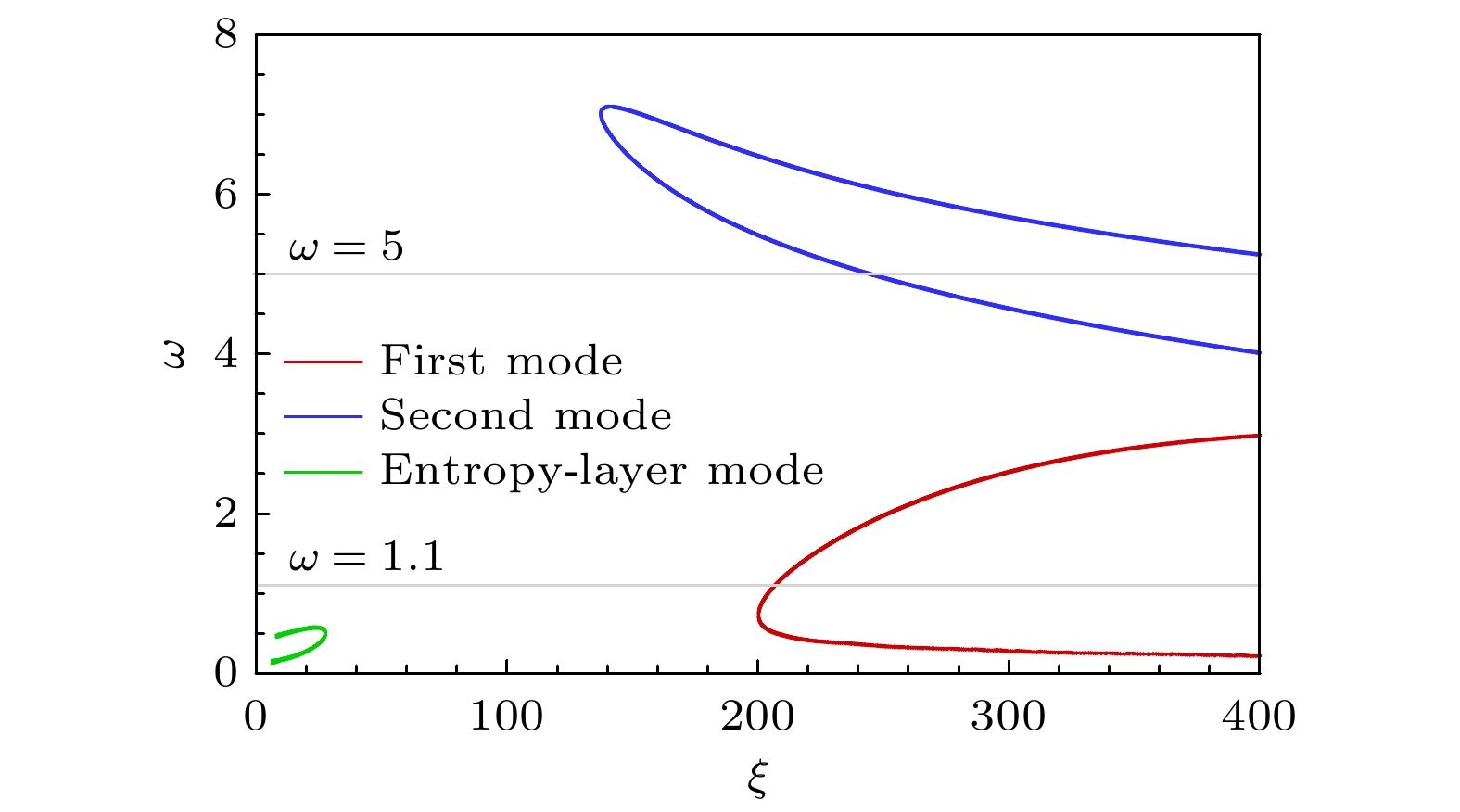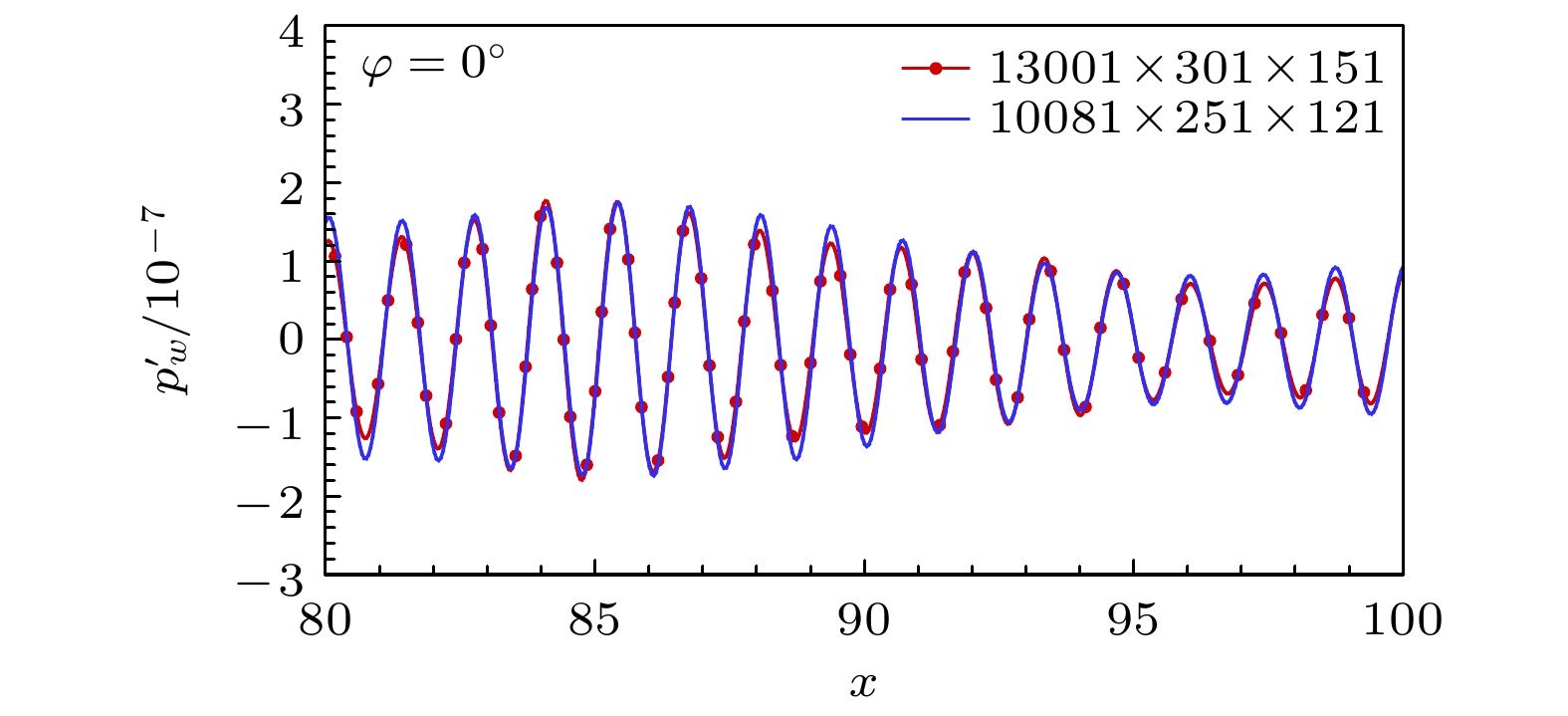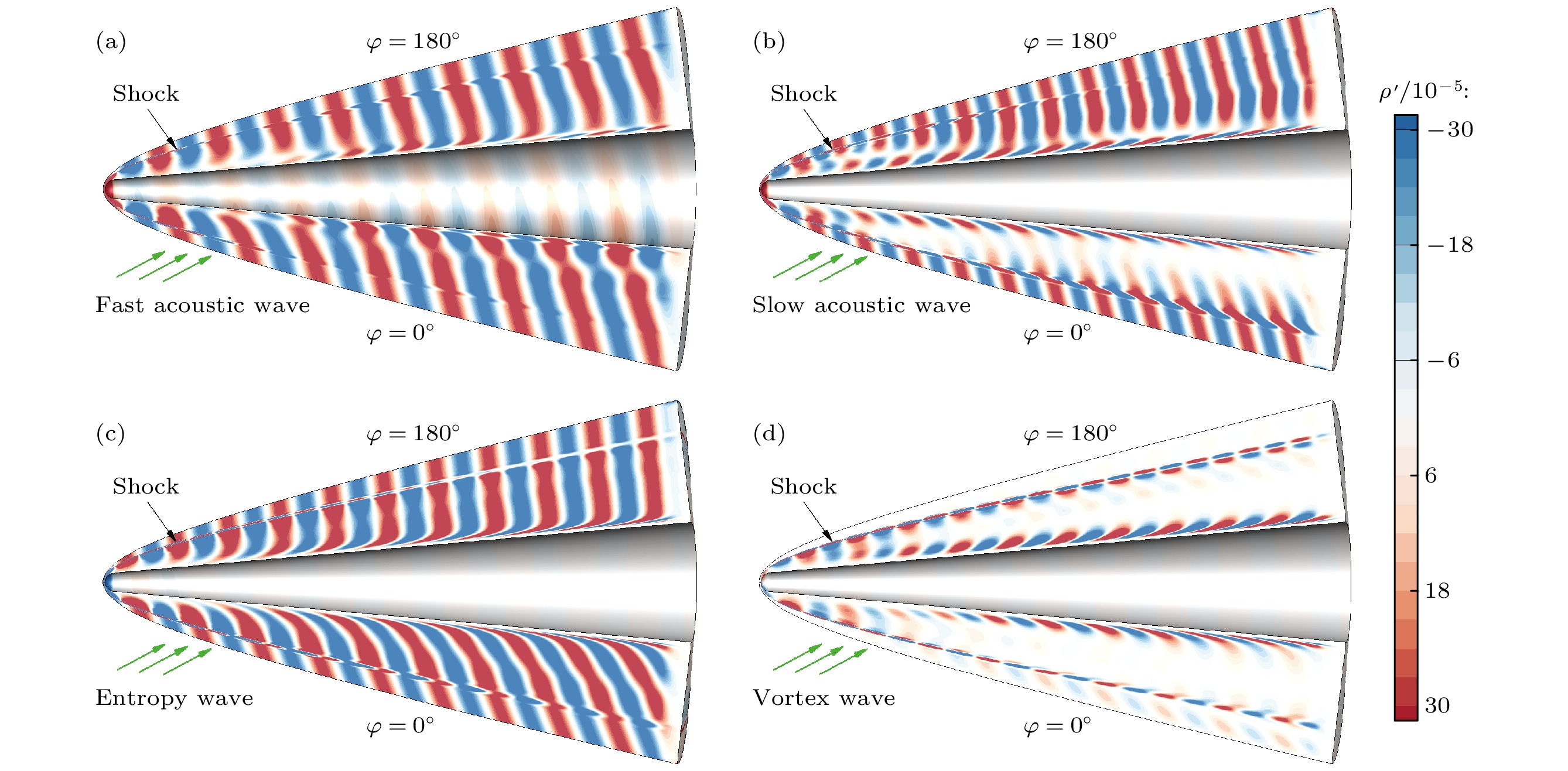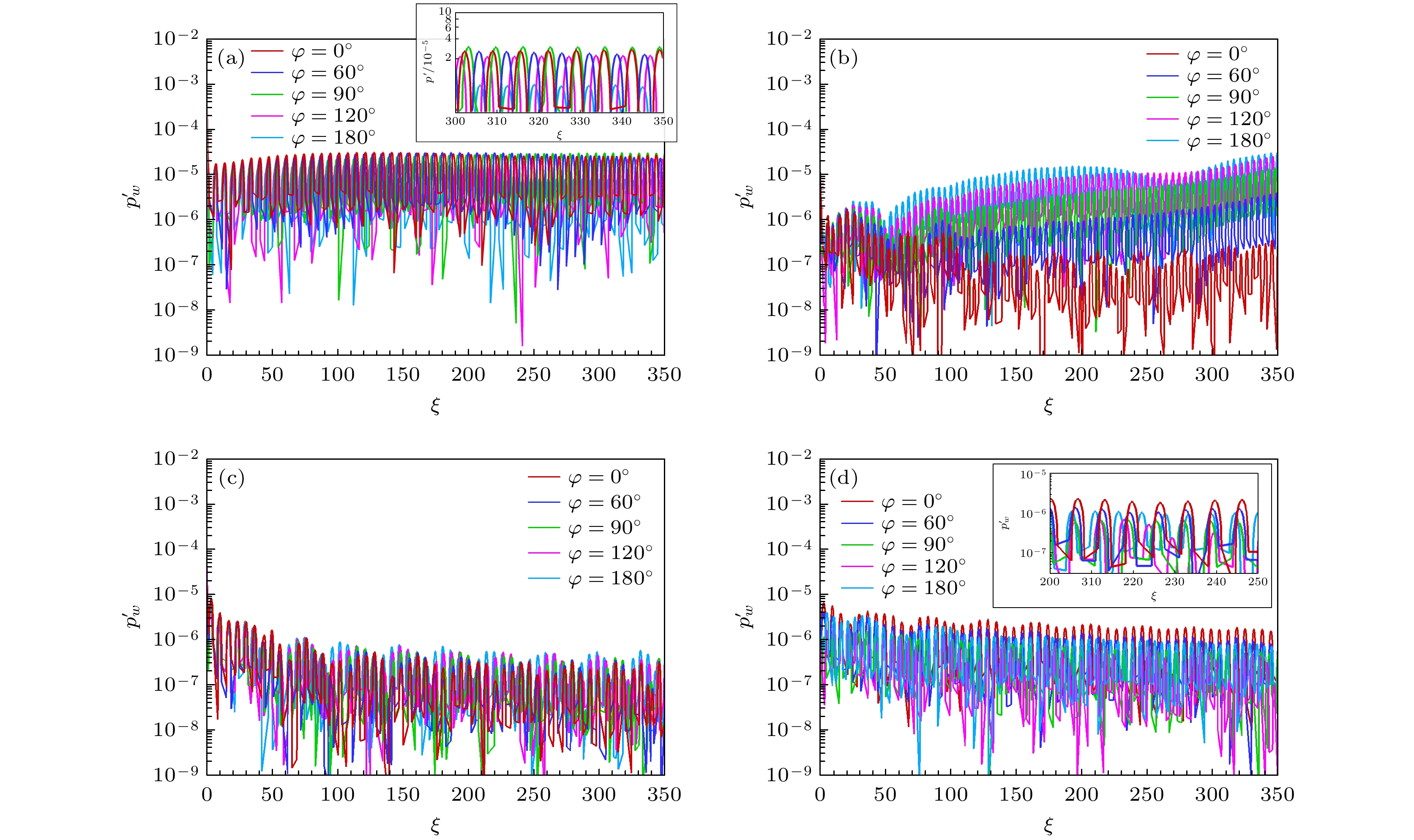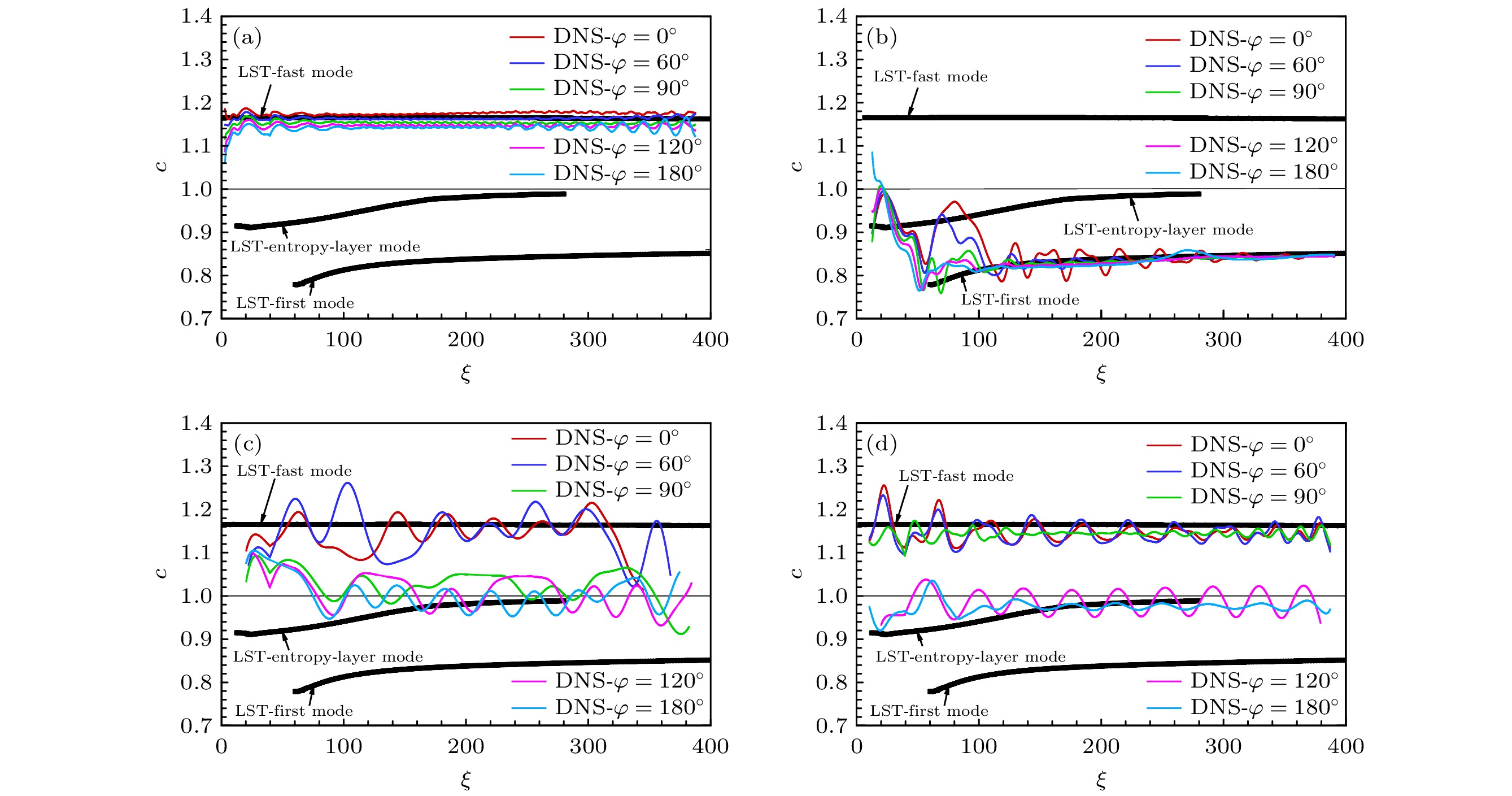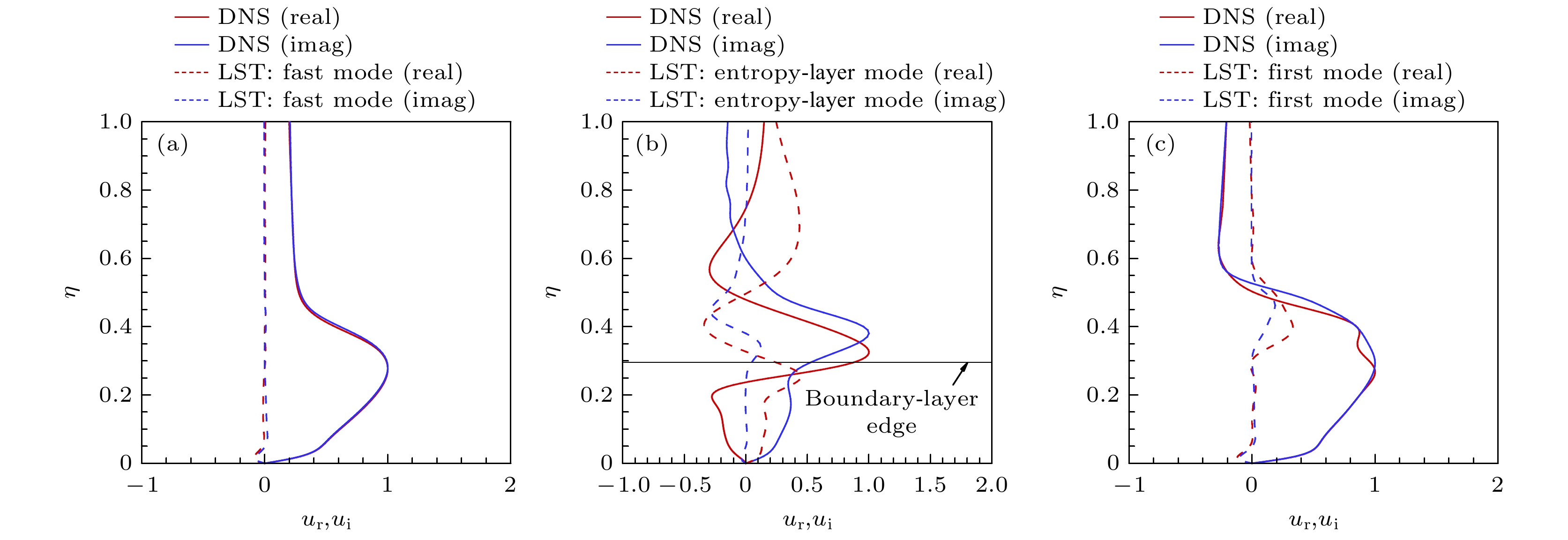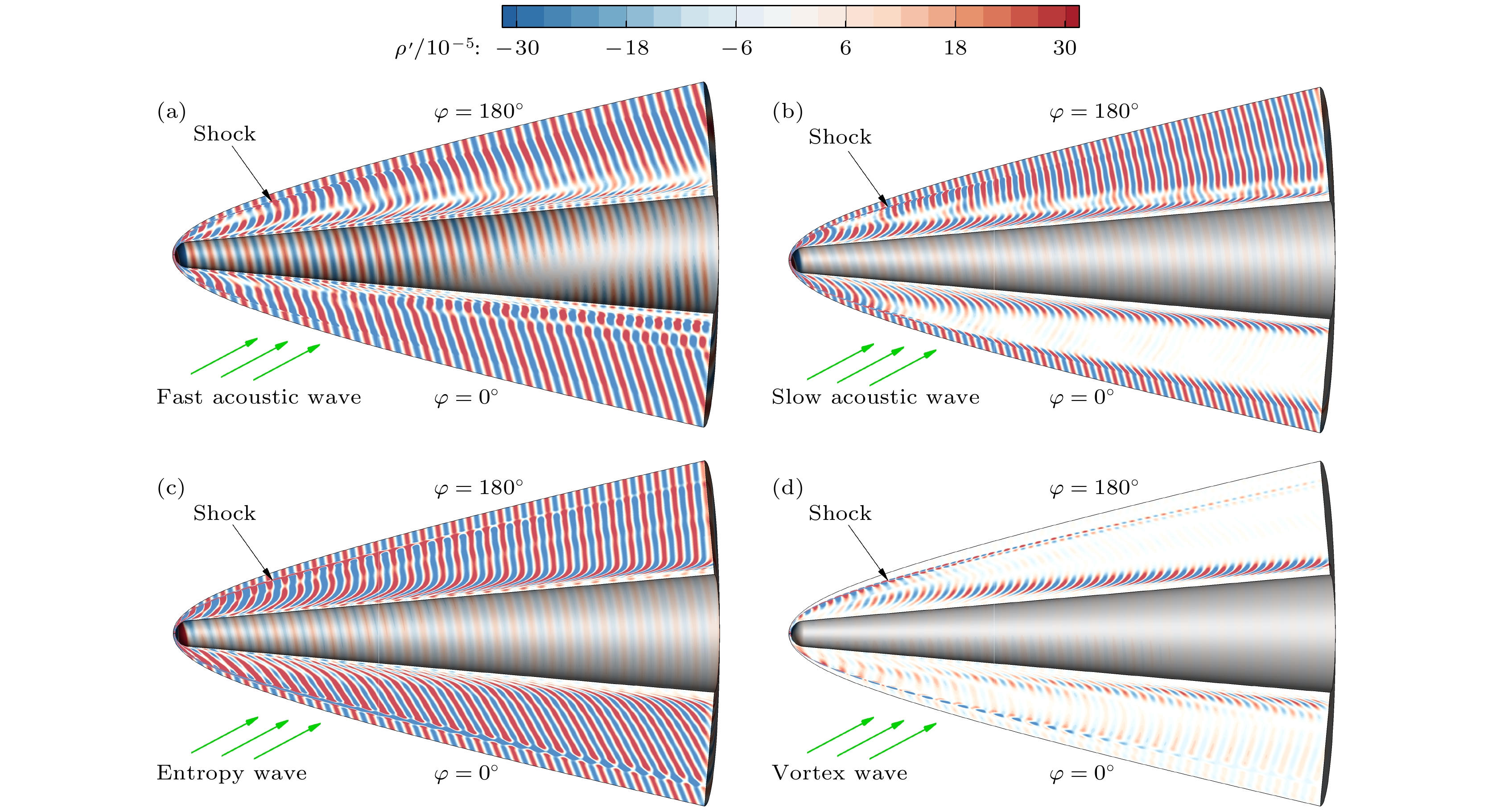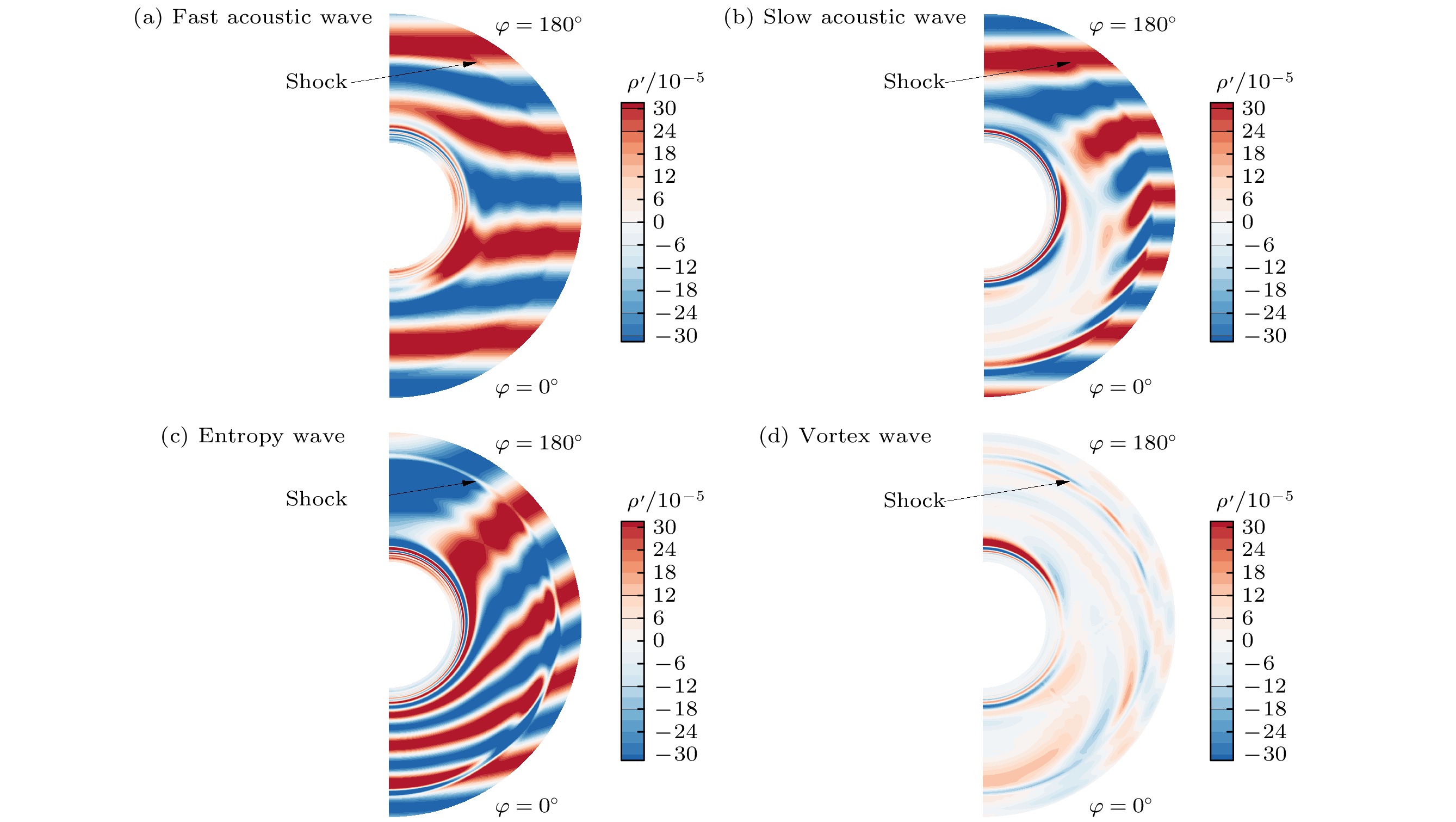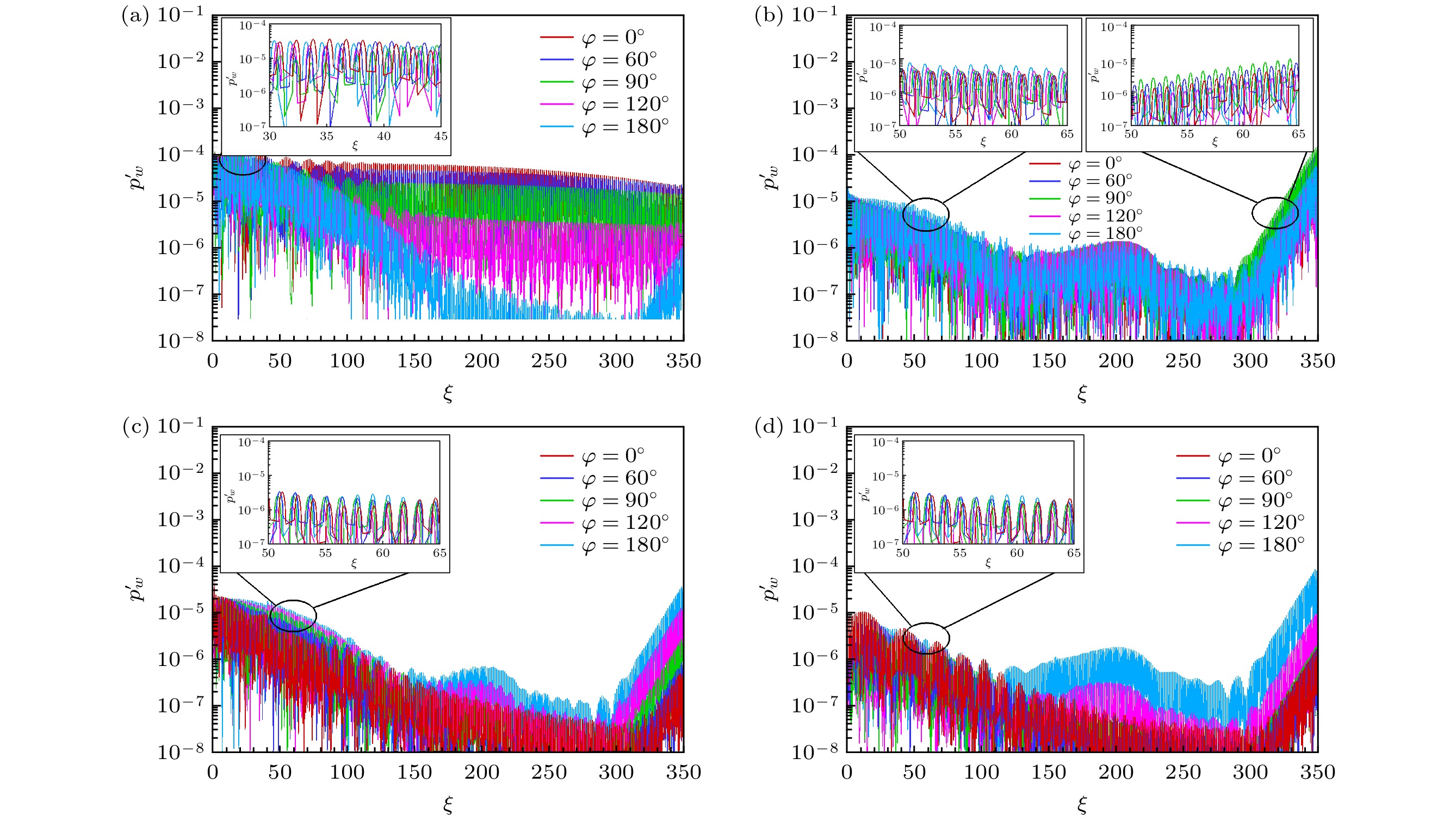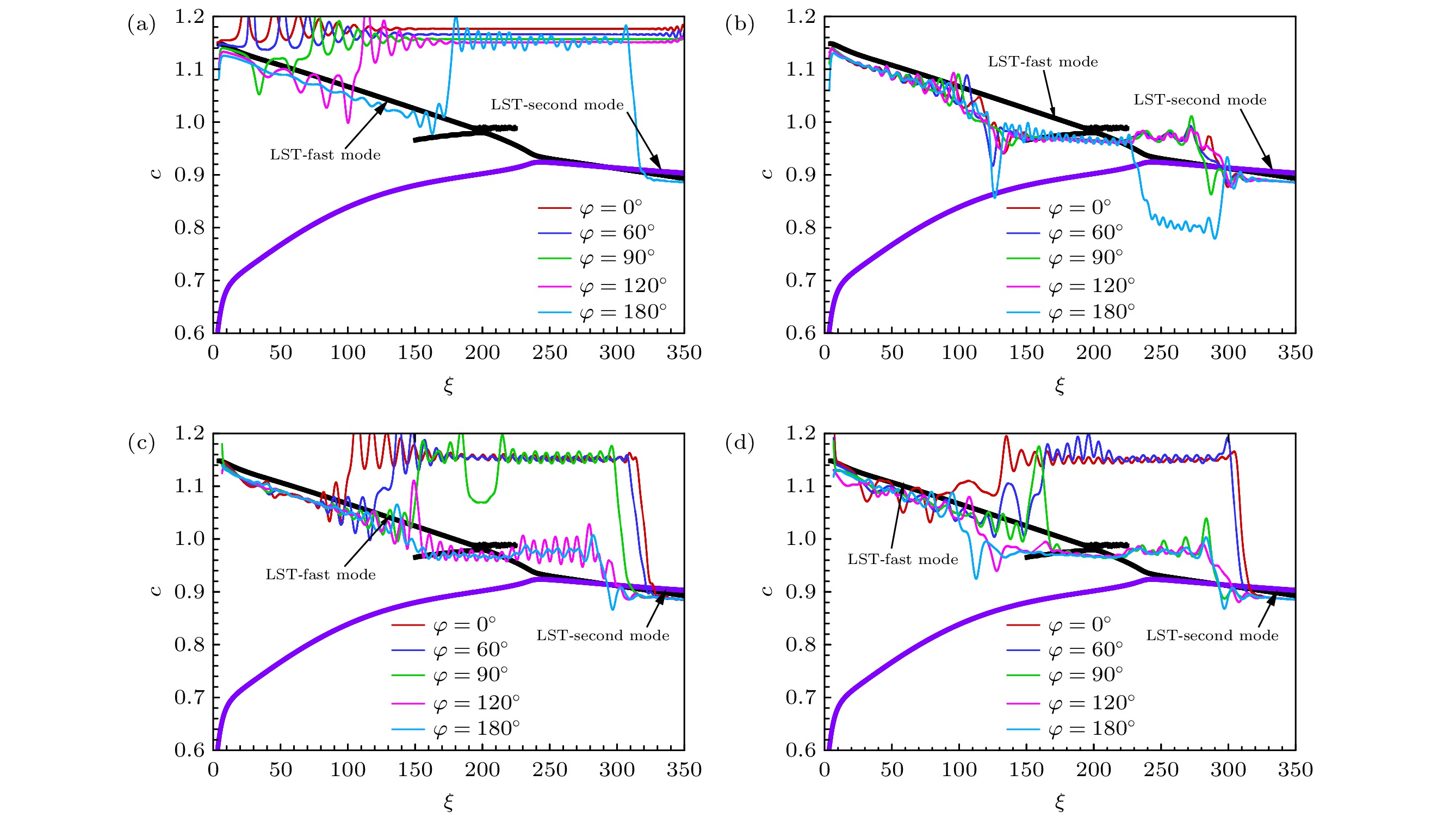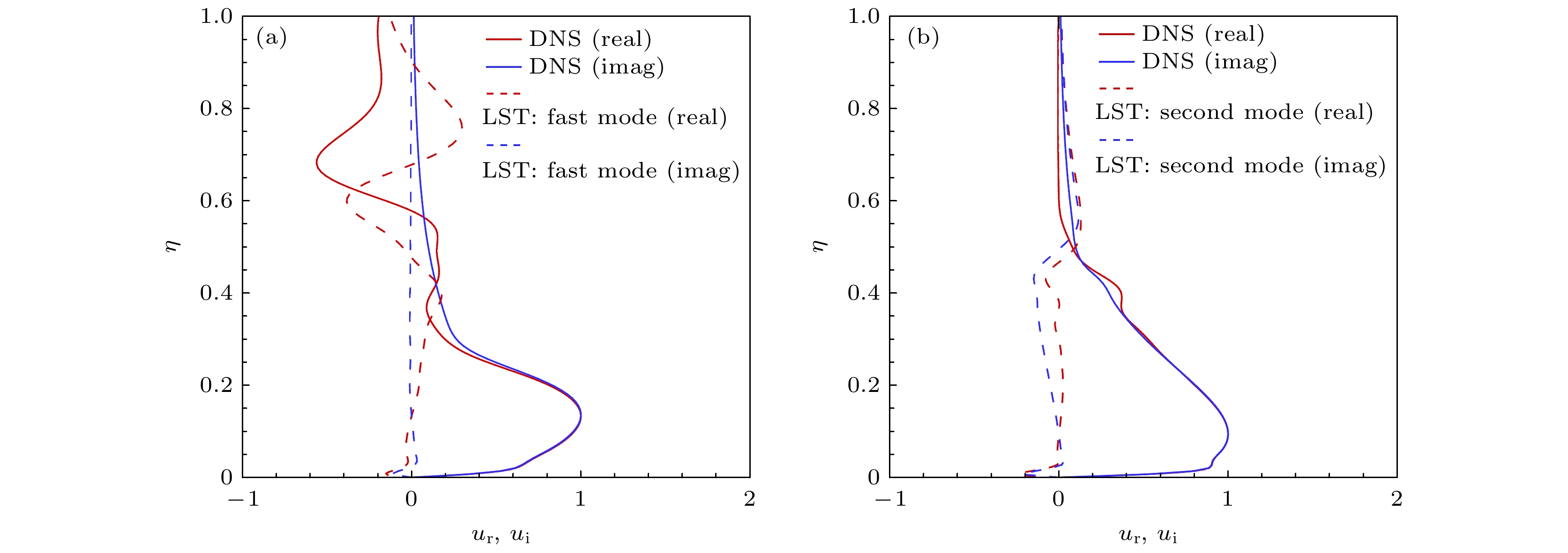-
来流扰动感受性是边界层转捩的起始阶段, 能决定边界层扰动以何种路径触发转捩. 目前二维感受性研究较为充分, 但现实来流扰动往往以非零角入射, 导致空间扰动在圆锥周向上存在分量, 造成感受性呈现三维特征, 该问题研究偏少. 前期仅研究了低频慢声波入射的三维感受性, 对于不同类型扰动的三维感受性问题还未做系统性研究. 本文采用高精度三维数值模拟技术和线性稳定性理论, 开展有入射角的不同频率快/慢声波、熵波和涡波的钝锥三维感受性研究. 结果发现, 入射慢声波能够激发边界层第一和第二模态; 快声波很难激发不稳定模态; 熵波和涡波在低频条件下难以激发第一模态, 但在高频下可激发第二模态. 扰动入射角可造成感受性因周向位置而异, 体现在主导扰动形式的差异和边界层扰动幅值的差异. 不同扰动类型、频率下这种差异表现出不同的规律, 入射正面、背面和侧面都有可能是最强感受性. 导致这些现象可能是上游头部和入射正面扰动的共同作用结果.Receptivity to freestream disturbances is the initial stage of the boundary-layer transition process, which can determine the final path of boundary-layer disturbance triggering transition. At present, there is relatively sufficient research on the receptivity of two-dimensional boundary layers to zero incident angle disturbances. In fact, the freestream disturbances often propagate into the boundary layer in the form of non-zero incident angle, resulting in a component of spatial disturbance in the circumferential direction of rotating body (such as a cone). It is a receptivity problem with distinct three-dimensional features. However, there is relatively little research on this three-dimensional receptivity issue. The preliminary work only studied the three-dimensional receptivity to low-frequency incident slow acoustic waves. There has not been a systematic study on the three-dimensional receptivity to different types of freestream disturbances. The three-dimensional receptivity of a blunt cone to different freestream disturbances is studied in this work. Firstly, a high-resolution numerical simulation method is used to investigate the three-dimensional receptivity process by introducing freestream disturbances with an incident angle of 15°. The freestream disturbances include fast acoustic wave, slow acoustic wave, entropy wave, and vortex wave. Their frequencies are chosen as dimensionless 1.1 and 5, corresponding to the first mode frequency and the second mode frequency, respectively. Then, the phase velocity and shape function of the boundary-layer disturbances at each position of circumference for the numerical results are obtained by Fourier transform. To explain the receptivity mechanisms, the corresponding results by linear stability analysis are obtained for comparisons. The results are shown below. The first mode and the second mode of the boundary layer can be effectively excited by the incident slow acoustic waves; it is difficult for the incident fast acoustic waves to excite unstable modes in the boundary layer; the incident entropy wave and vortex wave are difficult to excite the first mode at low frequency, but can excite the second mode at high frequency. Furthermore, the incident angle of the freestream disturbances can lead to the differences in the receptivity at different circumferential positions of the cone, which can be reflected in two ways. One is the difference in the dominant disturbance form at different circumferential positions, and the other is the difference in the amplitude of boundary-layer disturbances. Under different disturbance types and frequencies, these differences between different circumferential positions exhibit different results. The strongest receptivity may occur on the incident front, the incident back, and the incident side. These phenomena may result from the combined action of the upstream head disturbance and the disturbance on the incident front.
-
Keywords:
- receptivity /
- freestream disturbances /
- numerical simulation /
- stability analysis
[1] 陈坚强, 涂国华, 张毅锋, 徐国亮, 袁先旭, 陈诚 2017 空气动力学学报 35 311
 Google Scholar
Google Scholar
Chen J Q, Tu G H, Zhang Y F, Xu G L, Yuan X X, Chen C 2017 Acta Aero. Sin. 35 311
 Google Scholar
Google Scholar
[2] Saric W S, Reed H L, Kerschen E J 2002 Annu. Rev. Fluid Mech. 34 291
 Google Scholar
Google Scholar
[3] 周恒, 张涵信 2017 空气动力学学报 35 151
 Google Scholar
Google Scholar
Zhou H, Zhang H X 2017 Acta Aero. Sin. 35 151
 Google Scholar
Google Scholar
[4] Goldstein M E 1983 J. Fluid Mech. 127 59
 Google Scholar
Google Scholar
[5] Goldstein M E 1985 J. Fluid Mech. 154 509
 Google Scholar
Google Scholar
[6] Ruban A I 1985 Fluid Dyn. 19 709
 Google Scholar
Google Scholar
[7] Choudhari M, Streett C 1992 Phys. Fluids 4 2495
 Google Scholar
Google Scholar
[8] Choudhari M 1993 Theor. Comp. Fluid Dyn. 4 101
 Google Scholar
Google Scholar
[9] Duck P W, Ruban A I, Zhikharev C N 1996 J. Fluid Mech. 312 341
 Google Scholar
Google Scholar
[10] Hammerton P W, Kerschen E J 1996 J. Fluid Mech. 310 243
 Google Scholar
Google Scholar
[11] Wanderley J B V, Corke T C 2001 J. Fluid Mech. 429 1
 Google Scholar
Google Scholar
[12] Wu X S 2001 J. Fluid Mech. 449 373
 Google Scholar
Google Scholar
[13] Wu X S 2001 J. Fluid Mech. 431 91
 Google Scholar
Google Scholar
[14] Dong M, Liu Y H, Wu X S 2020 J. Fluid Mech. 896 A23
 Google Scholar
Google Scholar
[15] 陆昌根, 朱晓清, 沈露予 2017 物理学报 66 204702
 Google Scholar
Google Scholar
Lu C G, Zhu X Q, Shen L Y 2017 Acta Phys. Sin. 66 204702
 Google Scholar
Google Scholar
[16] Fedorov A 2011 Annu. Rev. Fluid Mech. 43 79
 Google Scholar
Google Scholar
[17] Zhong X, Wang X 2012 Annu. Rev. Fluid Mech. 44 527
 Google Scholar
Google Scholar
[18] 江贤洋, 李存标 2017 实验流体力学 31 1
 Google Scholar
Google Scholar
Jiang X Y, Lee C B 2017 J. Exp. Fluid Mech. 31 1
 Google Scholar
Google Scholar
[19] 苏彩虹 2020 空气动力学学报 38 355
 Google Scholar
Google Scholar
Su C H 2020 Acta Aero. Sin. 38 355
 Google Scholar
Google Scholar
[20] Fedorov A V, Khokhlov A P 1991 Fluid Dyn. 26 531
 Google Scholar
Google Scholar
[21] Fedorov A V, Khokhlov A P 2001 Theor. Comp. Fluid Dyn. 14 359
 Google Scholar
Google Scholar
[22] Fedorov A V 2003 J. Fluid Mech. 491 101
 Google Scholar
Google Scholar
[23] Ma Y B, Zhong X L 2003 J. Fluid Mech. 488 31
 Google Scholar
Google Scholar
[24] Ma Y B, Zhong X L 2003 J. Fluid Mech. 488 79
 Google Scholar
Google Scholar
[25] Ma Y B, Zhong X L 2005 J. Fluid Mech. 532 63
 Google Scholar
Google Scholar
[26] Zhong X L, Ma Y B 2006 J. Fluid Mech. 556 55
 Google Scholar
Google Scholar
[27] He S M, Zhong X L 2021 AIAA J. 59 3546
 Google Scholar
Google Scholar
[28] He S M, Zhong X L 2022 Phys. Fluids 34 054104
 Google Scholar
Google Scholar
[29] Balakumar P 2006 36th AIAA Fluid Dynamics Conference and Exhibit. San Francisco, California, June 5–8, p3053
[30] Balakumar P 2015 49th AIAA Fluid Dynamics Conference Dallas, Texas, p247
[31] Balakumar P, King R A, Chou A, Owens L R, Kegerise M A 2018 AIAA J. 56 510
 Google Scholar
Google Scholar
[32] 张玉东, 傅德薰, 马延文, 李新亮 2008 中国科学G辑, 物理学 力学 天文学 38 1246
Zhang Y D, Fu D X, Ma Y W, Li X L 2008 Sci. Sin. Phys. Mech. Astron. 38 1246
[33] Qin F F, Wu X S 2016 J. Fluid Mech. 797 874
 Google Scholar
Google Scholar
[34] Ba W T, Niu M H, Su C H 2023 AIAA J. 61 518
 Google Scholar
Google Scholar
[35] Niu M H, Su C H 2023 Phy. Fluids 35 034109
 Google Scholar
Google Scholar
[36] Wan B B, Luo J S, Su C H 2018 Appl. Math. Mech. (English Edition) 39 1643
 Google Scholar
Google Scholar
[37] Wan B B, Su C H, Chen J Q 2020 AIAA J. 58 4047
 Google Scholar
Google Scholar
[38] Chen Y F, Tu G H, Wan B B, Su C H, Yuan X X, Chen J Q 2021 Phys. Fluids 33 084114
 Google Scholar
Google Scholar
[39] Stetson K F, Thompson E R, Donaldson J C, Siler L G 1984 AIAA 22nd Aerospace Sciences Meeting Reno, Nevada, January 9–12, 1984 p0006
[40] Fedorov A V 1990 J. Appl. Mech. Tech. Phy. 31 722
 Google Scholar
Google Scholar
[41] 万兵兵, 罗纪生 2018 空气动力学学报 36 247
 Google Scholar
Google Scholar
Wan B B, Luo J S 2018 Acta Aero. Sin. 36 247
 Google Scholar
Google Scholar
[42] 欧吉辉, 万兵兵, 刘建新, 曹伟 2018 空气动力学报 36 238
 Google Scholar
Google Scholar
Ou J H, Wan B B, Liu J X, Cao W 2018 Acta Aero. Sin. 36 238
 Google Scholar
Google Scholar
[43] Han Y F, Zhou J T, Cao W 2022 Phys. Fluids 34 026101
 Google Scholar
Google Scholar
[44] McKenzie J F, Westphal K O 1968 Phys. Fluids 11 2350
 Google Scholar
Google Scholar
[45] Su C H, Geng J L 2017 Appl. Math. Mech. (English Edition) 38 1601
 Google Scholar
Google Scholar
[46] Huang Z F, Wang H L 2019 J. Fluid Mech. 873 1179
 Google Scholar
Google Scholar
[47] Malik M R, Balakumar P 2007 Theor. Comp. Fluid Dyn. 21 323
 Google Scholar
Google Scholar
[48] Balakumar P 2007 37th AIAA Fluid Dynamics Conference and Exhibit Miami, FL, June 25–28, 2007 p4491
[49] Wan B B, Chen J Q, Yuan X X, Hu W B, Tu G H 2022 AIAA J. 60 4523
 Google Scholar
Google Scholar
[50] Zhang S H, Zhu J, Shu C 2019 Adv. Aerod. 1 16
 Google Scholar
Google Scholar
[51] Ma Y K, Mao M L, Yan Z G, Bai J W, Zhu H J 2024 J. Comp. Phy. 510 113064
 Google Scholar
Google Scholar
-
图 9 不同扰动形状函数与稳定性理论(快模态、熵层模态和第一模态)比较 (a) 快声波, ξ = 200, φ = 90; (b)慢声波, ξ = 60, φ = 90; (c)慢声波, ξ = 350, φ = 90
Fig. 9. Disturbance shape functions (fast mode, entropy-layer mode, and first mode) compared with the stability theory: (a) Fast acoustic wave, ξ = 200, φ = 90; (b) slow acoustic wave, ξ = 60, φ = 90; (c) slow acoustic wave, ξ = 350, φ = 90.
-
[1] 陈坚强, 涂国华, 张毅锋, 徐国亮, 袁先旭, 陈诚 2017 空气动力学学报 35 311
 Google Scholar
Google Scholar
Chen J Q, Tu G H, Zhang Y F, Xu G L, Yuan X X, Chen C 2017 Acta Aero. Sin. 35 311
 Google Scholar
Google Scholar
[2] Saric W S, Reed H L, Kerschen E J 2002 Annu. Rev. Fluid Mech. 34 291
 Google Scholar
Google Scholar
[3] 周恒, 张涵信 2017 空气动力学学报 35 151
 Google Scholar
Google Scholar
Zhou H, Zhang H X 2017 Acta Aero. Sin. 35 151
 Google Scholar
Google Scholar
[4] Goldstein M E 1983 J. Fluid Mech. 127 59
 Google Scholar
Google Scholar
[5] Goldstein M E 1985 J. Fluid Mech. 154 509
 Google Scholar
Google Scholar
[6] Ruban A I 1985 Fluid Dyn. 19 709
 Google Scholar
Google Scholar
[7] Choudhari M, Streett C 1992 Phys. Fluids 4 2495
 Google Scholar
Google Scholar
[8] Choudhari M 1993 Theor. Comp. Fluid Dyn. 4 101
 Google Scholar
Google Scholar
[9] Duck P W, Ruban A I, Zhikharev C N 1996 J. Fluid Mech. 312 341
 Google Scholar
Google Scholar
[10] Hammerton P W, Kerschen E J 1996 J. Fluid Mech. 310 243
 Google Scholar
Google Scholar
[11] Wanderley J B V, Corke T C 2001 J. Fluid Mech. 429 1
 Google Scholar
Google Scholar
[12] Wu X S 2001 J. Fluid Mech. 449 373
 Google Scholar
Google Scholar
[13] Wu X S 2001 J. Fluid Mech. 431 91
 Google Scholar
Google Scholar
[14] Dong M, Liu Y H, Wu X S 2020 J. Fluid Mech. 896 A23
 Google Scholar
Google Scholar
[15] 陆昌根, 朱晓清, 沈露予 2017 物理学报 66 204702
 Google Scholar
Google Scholar
Lu C G, Zhu X Q, Shen L Y 2017 Acta Phys. Sin. 66 204702
 Google Scholar
Google Scholar
[16] Fedorov A 2011 Annu. Rev. Fluid Mech. 43 79
 Google Scholar
Google Scholar
[17] Zhong X, Wang X 2012 Annu. Rev. Fluid Mech. 44 527
 Google Scholar
Google Scholar
[18] 江贤洋, 李存标 2017 实验流体力学 31 1
 Google Scholar
Google Scholar
Jiang X Y, Lee C B 2017 J. Exp. Fluid Mech. 31 1
 Google Scholar
Google Scholar
[19] 苏彩虹 2020 空气动力学学报 38 355
 Google Scholar
Google Scholar
Su C H 2020 Acta Aero. Sin. 38 355
 Google Scholar
Google Scholar
[20] Fedorov A V, Khokhlov A P 1991 Fluid Dyn. 26 531
 Google Scholar
Google Scholar
[21] Fedorov A V, Khokhlov A P 2001 Theor. Comp. Fluid Dyn. 14 359
 Google Scholar
Google Scholar
[22] Fedorov A V 2003 J. Fluid Mech. 491 101
 Google Scholar
Google Scholar
[23] Ma Y B, Zhong X L 2003 J. Fluid Mech. 488 31
 Google Scholar
Google Scholar
[24] Ma Y B, Zhong X L 2003 J. Fluid Mech. 488 79
 Google Scholar
Google Scholar
[25] Ma Y B, Zhong X L 2005 J. Fluid Mech. 532 63
 Google Scholar
Google Scholar
[26] Zhong X L, Ma Y B 2006 J. Fluid Mech. 556 55
 Google Scholar
Google Scholar
[27] He S M, Zhong X L 2021 AIAA J. 59 3546
 Google Scholar
Google Scholar
[28] He S M, Zhong X L 2022 Phys. Fluids 34 054104
 Google Scholar
Google Scholar
[29] Balakumar P 2006 36th AIAA Fluid Dynamics Conference and Exhibit. San Francisco, California, June 5–8, p3053
[30] Balakumar P 2015 49th AIAA Fluid Dynamics Conference Dallas, Texas, p247
[31] Balakumar P, King R A, Chou A, Owens L R, Kegerise M A 2018 AIAA J. 56 510
 Google Scholar
Google Scholar
[32] 张玉东, 傅德薰, 马延文, 李新亮 2008 中国科学G辑, 物理学 力学 天文学 38 1246
Zhang Y D, Fu D X, Ma Y W, Li X L 2008 Sci. Sin. Phys. Mech. Astron. 38 1246
[33] Qin F F, Wu X S 2016 J. Fluid Mech. 797 874
 Google Scholar
Google Scholar
[34] Ba W T, Niu M H, Su C H 2023 AIAA J. 61 518
 Google Scholar
Google Scholar
[35] Niu M H, Su C H 2023 Phy. Fluids 35 034109
 Google Scholar
Google Scholar
[36] Wan B B, Luo J S, Su C H 2018 Appl. Math. Mech. (English Edition) 39 1643
 Google Scholar
Google Scholar
[37] Wan B B, Su C H, Chen J Q 2020 AIAA J. 58 4047
 Google Scholar
Google Scholar
[38] Chen Y F, Tu G H, Wan B B, Su C H, Yuan X X, Chen J Q 2021 Phys. Fluids 33 084114
 Google Scholar
Google Scholar
[39] Stetson K F, Thompson E R, Donaldson J C, Siler L G 1984 AIAA 22nd Aerospace Sciences Meeting Reno, Nevada, January 9–12, 1984 p0006
[40] Fedorov A V 1990 J. Appl. Mech. Tech. Phy. 31 722
 Google Scholar
Google Scholar
[41] 万兵兵, 罗纪生 2018 空气动力学学报 36 247
 Google Scholar
Google Scholar
Wan B B, Luo J S 2018 Acta Aero. Sin. 36 247
 Google Scholar
Google Scholar
[42] 欧吉辉, 万兵兵, 刘建新, 曹伟 2018 空气动力学报 36 238
 Google Scholar
Google Scholar
Ou J H, Wan B B, Liu J X, Cao W 2018 Acta Aero. Sin. 36 238
 Google Scholar
Google Scholar
[43] Han Y F, Zhou J T, Cao W 2022 Phys. Fluids 34 026101
 Google Scholar
Google Scholar
[44] McKenzie J F, Westphal K O 1968 Phys. Fluids 11 2350
 Google Scholar
Google Scholar
[45] Su C H, Geng J L 2017 Appl. Math. Mech. (English Edition) 38 1601
 Google Scholar
Google Scholar
[46] Huang Z F, Wang H L 2019 J. Fluid Mech. 873 1179
 Google Scholar
Google Scholar
[47] Malik M R, Balakumar P 2007 Theor. Comp. Fluid Dyn. 21 323
 Google Scholar
Google Scholar
[48] Balakumar P 2007 37th AIAA Fluid Dynamics Conference and Exhibit Miami, FL, June 25–28, 2007 p4491
[49] Wan B B, Chen J Q, Yuan X X, Hu W B, Tu G H 2022 AIAA J. 60 4523
 Google Scholar
Google Scholar
[50] Zhang S H, Zhu J, Shu C 2019 Adv. Aerod. 1 16
 Google Scholar
Google Scholar
[51] Ma Y K, Mao M L, Yan Z G, Bai J W, Zhu H J 2024 J. Comp. Phy. 510 113064
 Google Scholar
Google Scholar
计量
- 文章访问数: 3096
- PDF下载量: 151
- 被引次数: 0















 下载:
下载:
